

Aboriginal Music Program. o02. Aboriginal Children: The Healing Power of Cultural Identity - Childhood and Adolescence. Every day, 10 to 20 toddlers and preschool children gather at the Katl'odeeche First Nation Children's Centre on the Hay River Dene Reserve, Northwest Territories.
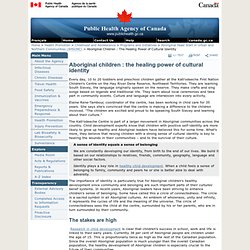
They are learning South Slavey, the language originally spoken on the reserve. They make crafts and sing songs based on legends and traditional life. They learn about local ceremonies and take part in community events. Culture and language are interwoven into every activity. Elaine Rene-Tambour, coordinator of the centre, has been working in child care for 35 years. T.W.O. Aboriginal Art - Aboriginal Art Stoney Creek. Culture and Traditions - Aseniwuche Winewak Nation of Canada - Canada's Rocky Mountain Aboriginal People. People had a yearly round dance to memorialize the death of one or more persons.
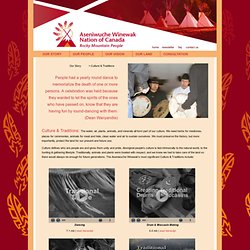
A celebration was held because they wanted to let the spirits of the ones who have passed on, know that they are having fun by round-dancing with them. (Dean Wanyandie) Culture & Traditions: The water, air, plants, animals, and minerals all form part of our culture. We need herbs for medicines, places for ceremonies, animals for meat and hide, clean water and air to sustain ourselves. We must preserve the history, but more importantly, protect the land for our present and future use. Culture defines who are people are and gives them unity and pride. Dancing7.1 mb | read transcript Drum & Moccasin Making4.4 mb | read transcript Medicine Gathering3.4 mb | read transcript Guiding & Outfitting 7.7 mb | read transcript Transcript for Traditional Dance Video The video begins with footage of traditional pow wow dancers.
The video changes to an interview with a young girl named Alex Ceaser. Traditional Land Use Camp Video. Cjnsv19no1_pg1-36. Centre for Aboriginal Culture and Education (CACE) - Carleton University. Carleton University acknowledges the location of its campus on the traditional, unceded territories of the Algonquin nation.
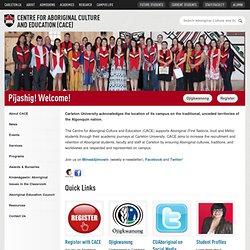
The Centre for Aboriginal Culture and Education (CACE) supports Aboriginal (First Nations, Inuit and Métis) students through their academic journeys at Carleton University. CACE aims to increase the recruitment and retention of Aboriginal students, faculty and staff at Carleton by ensuring Aboriginal cultures, traditions, and worldviews are respected and represented on campus. Join us on Minwàdjimowin (weekly e-newsletter), Facebook and Twitter! Recent News Call for Student Artwork! The 2014 Indigenous Graduate Honouring Ceremony organizing committee is looking for photos of artwork by students and alumni to show as part of a slideshow during the ceremony. What is a Powwow? Aboriginal peoples in Canada. The characteristics of Canadian Aboriginal civilizations included permanent settlements,[8] agriculture,[9] civic and ceremonial architecture,[10] complex societal hierarchies and trading networks.[11] The Métis culture of mixed blood originated in the mid-17th century when First Nation and Inuit people married Europeans.[12] The Inuit had more limited interaction with European settlers during that early period.[13] Various laws, treaties, and legislation have been enacted between European immigrants and First Nations across Canada.
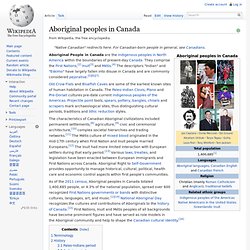
Aboriginal Right to Self-Government provides opportunity to manage historical, cultural, political, health care and economic control aspects within first people's communities. Terminology[edit] First Nations in Canada. Introduction First Nations in Canada is an educational resource designed for use by young Canadians; high school educators and students; Aboriginal communities; and anyone interested in First Nations history.
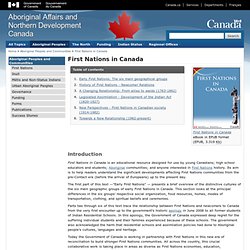
Its aim is to help readers understand the significant developments affecting First Nations communities from the pre-Contact era (before the arrival of Europeans) up to the present day. The first part of this text —"Early First Nations" — presents a brief overview of the distinctive cultures of the six main geographic groups of early First Nations in Canada. This section looks at the principal differences in the six groups' respective social organization, food resources, homes, modes of transportation, clothing, and spiritual beliefs and ceremonies.
Today the Government of Canada is working in partnership with First Nations in this new era of reconciliation to build stronger First Nations communities.